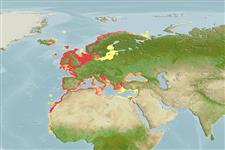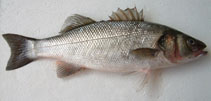Dicentrarchus labrax (Linnaeus, 1758)
European seabass
Add your observation in Fish Watcher
| Native range | All suitable habitat | Point map | Year 2050 |

|
| This map was computer-generated and has not yet been reviewed. |
| Dicentrarchus labrax AquaMaps Data sources: GBIF OBIS |
Upload your photos and videos
Pictures | Videos | Google imageDicentrarchus labrax
Picture by Crocetta, F.
Pictures | Videos | Google imageDicentrarchus labrax
Picture by Crocetta, F.
Slovenia country information
Common names:
Brancin, Luben
Occurrence: native
Salinity: brackish
Abundance: | Ref:
Importance: | Ref:
Aquaculture: | Ref:
Regulations: | Ref:
Uses: no uses
Comments: Gulf of Trieste. Also Ref. 27929. Status of threat: insufficiently known in Adriatic river basin (Ref. 90061).
National Checklist:
Country Information: https://www.cia.gov/library/publications/resources/the-world-factbook/geos/si.html
National Fisheries Authority:
Occurrences: Occurrences Point map
Main Ref: Povz, M., 1996
National Database:
Occurrence: native
Salinity: brackish
Abundance: | Ref:
Importance: | Ref:
Aquaculture: | Ref:
Regulations: | Ref:
Uses: no uses
Comments: Gulf of Trieste. Also Ref. 27929. Status of threat: insufficiently known in Adriatic river basin (Ref. 90061).
National Checklist:
Country Information: https://www.cia.gov/library/publications/resources/the-world-factbook/geos/si.html
National Fisheries Authority:
Occurrences: Occurrences Point map
Main Ref: Povz, M., 1996
National Database:
Common names from other countries
Classification / Names Populärnamn | synonymer | Catalog of Fishes(Släkte, Arter) | ITIS | CoL | WoRMS | Cloffa
> Eupercaria/misc (Various families in series Eupercaria) > Moronidae (Temperate basses)
Etymology: Dicentrarchus: Greek, di = two + Greek, kentron = sting + Greek, archos = anus (Ref. 45335).
More on author: Linnaeus.
Etymology: Dicentrarchus: Greek, di = two + Greek, kentron = sting + Greek, archos = anus (Ref. 45335).
More on author: Linnaeus.
Environment: milieu / climate zone / depth range / distribution range Ekologi
marina; sötvatten; brackvatten bottenlevande; havsvandrande; djupintervall 10 - 100 m (Ref. 9987). Subtropical; 8°C - 24°C (Ref. 4944); 72°N - 11°N, 19°W - 42°E (Ref. 54221)
Utbredning Länder | FAO områden | Ekosystem | Förekomster | Point map | Utplanteringar | Faunafri
Eastern Atlantic: Norway to Morocco, the Canary Islands and Senegal. Also known from the Mediterranean and Black Sea. Absent from White, Barents, Baltic and Caspian Seas (Ref. 59043).
Length at first maturity / Size / Vikt / Age
Maturity: Lm 36.1, range 23 - 46 cm
Max length : 103 cm TL hane/ej könsbestämd; (Ref. 40637); common length : 50.0 cm TL hane/ej könsbestämd; (Ref. 6916); publicerad maxvikt: 12.0 kg (Ref. 1468); rapporterad maxålder: 30 år (Ref. 59043)
Max length : 103 cm TL hane/ej könsbestämd; (Ref. 40637); common length : 50.0 cm TL hane/ej könsbestämd; (Ref. 6916); publicerad maxvikt: 12.0 kg (Ref. 1468); rapporterad maxålder: 30 år (Ref. 59043)
Short description Bestämningsnycklar | Morfologi | Morfometri
Taggstrålar i ryggfenan (totalt) : 8 - 10; Mjukstrålar i ryggfenan (totalt) : 12 - 13; Taggstrålar i analfenan: 3; Mjukstrålar i analfenan: 10 - 12. Diagnosis: head with cycloid scales above; mouth moderately protractile (Ref. 231). Vomerine teeth only anteriorly (Ref. 231), in a crescentic band (Ref. 231, 57391). Scales on interorbital space cycloid (Ref. 57391). Posterior edge of opercle finely serrated, lower edge with strong forward- directed denticles (Ref. 231). 2 flat opercular spines (Ref. 231, 57391). Young with some dark spots on upper part of body (Ref. 231).
Adults manifest demersal behavior, inhabit coastal waters down to about 100 m depth but more common in shallow waters (Ref. 54221, 57391). Found in the littoral zone on various kinds of bottoms on estuaries, lagoons and occasionally rivers. They enter coastal waters and river mouths in summer, but migrate offshore in colder weather and occur in deep water during winter in the northern range. Young fish form school, but adults appear to be less gregarious (Ref. 9987). Feed chiefly on shrimps and mollusks, also on fishes (Ref. 5990). Juveniles feed on invertebrates, taking increasingly more fish with age. Adults piscivorous . (Ref. 59043). Spawn in batches (Ref. 51846). Spawning takes place in the spring near the British Isles, and earlier in its southern range. Eggs are pelagic (Ref. 35388). Marketed fresh or smoked (Ref. 9987). Highly sought by sport fishermen (Ref. 30578).
Life cycle and mating behavior Könsmognad | Reproduktion | Lek | Ägg | Fecundity | Larver
Spawn in groups. Eggs are pelagic. In the Mediterranean, first sexual maturity occurs generally between 2 and 4 years of age while in the Atlantic sexual maturity happens a little later (males between 4-7 years and females between 5-8 years). Spawning happens just once a year and it tends to be in winter, although in southern areas it can occur in spring. Eggs have 1-2 fat drops that fuse about 12 hours after laying. Embryo development lasts about three days at 13-14°C and larval development about 40 days at 19°C. Egg size 1.1-1.5 mm, larval length at hatching 3 mm.
Main reference
Upload your references | referenser | Koordinator : Heemstra, Phillip C. | Medarbetare
Smith, C.L., 1990. Moronidae. p. 692-694. In J.C. Quero, J.C. Hureau, C. Karrer, A. Post and L. Saldanha (eds.) Check-list of the fishes of the eastern tropical Atlantic (CLOFETA). JNICT, Lisbon; SEI, Paris; and UNESCO, Paris. Vol. 2. (Ref. 6916)
IUCN Red List Status (Ref. 130435: Version 2024-2)
Near Threatened (NT) (Near Threatened); Date assessed: 03 March 2022
Threat to humans
Harmless
Human uses
Fiskeri: kommersiell; Vattenbruk: kommersiell; sportfisk: ja
FAO(Aquaculture systems: produktion, species profile; fiskeri: produktion, species profile; publication : search) | FishSource | Sea Around Us
Ytterligare information
Population dynamics
Tillväxtparametrar
Max. ages / sizes
Length-weight rel.
Length-length rel.
Length-frequencies
Mass conversion
Rekrytering
Abundans
Tillväxtparametrar
Max. ages / sizes
Length-weight rel.
Length-length rel.
Length-frequencies
Mass conversion
Rekrytering
Abundans
Life cycle
Reproduktion
Könsmognad
Fecundity
Lek
Spawning aggregations
Ägg
Egg development
Larver
Larvdynamik
Reproduktion
Könsmognad
Fecundity
Lek
Spawning aggregations
Ägg
Egg development
Larver
Larvdynamik
Physiology
Body composition
Nutrients
Syreförbrukning
Swimming type
Simhastighet
Visual pigments
Fish sound
Diseases & Parasites
Toxicity (LC50s)
Body composition
Nutrients
Syreförbrukning
Swimming type
Simhastighet
Visual pigments
Fish sound
Diseases & Parasites
Toxicity (LC50s)
Human related
Aquaculture systems
Vattenbruksprofiler
Avelslinjer
Ciguatera cases
Stamps, coins, misc.
Aquaculture systems
Vattenbruksprofiler
Avelslinjer
Ciguatera cases
Stamps, coins, misc.
Verktyg
E-book | Fälthandbok | Bestämningsnycklar | Längdfördelnings-verktyg | Livshistorie-verktyg | Prickkarta | Classification Tree
| Catch-MSY |
Special reports
Download XML
Internet-källor
Alien/Invasive Species database | Aquatic Commons | BHL | Cloffa | Websites from users | Check FishWatcher | CISTI | Catalog of Fishes(Släkte, Arter) | DiscoverLife | DORIS | ECOTOX | Faunafri | Fishtrace | GenBank(genome, nucleotide) | GloBI | GOBASE | | Google Books | Google Scholar | Google | IGFA World Record | MitoFish | Nationella databaser | OsteoBase(skull, spine) | Otolith Atlas of Taiwan Fishes | Offentliga akvarier | PubMed | Reef Life Survey | Scirus | SeaLifeBase | Tree of Life | Wikipedia(Go, sök) | World Records Freshwater Fishing | Zoological Record
Estimates based on models
Preferred temperature (Ref. 115969): 7.3 - 19.5, mean 10.7 (based on 788 cells).
Phylogenetic diversity index (Ref. 82804): PD50 = 0.7656 [Uniqueness, from 0.5 = low to 2.0 = high].
Bayesian length-weight: a=0.00933 (0.00780 - 0.01117), b=3.02 (2.97 - 3.07), in cm Total Length, based on LWR estimates for this species (Ref. 93245).
Trofisk nivå (Ref. 69278): 3.5 ±0.50 se; based on food items.
Resiliens (Ref. 120179): Mellan, lägsta populationsfördubblingstid 1,4-4,4 år (K=0.06-0.33; tm=2-8; tmax=30; Fec=230,000).
Prior r = 0.37, 95% CL = 0.25 - 0.56, Based on 10 full stock assessments.
Fishing Vulnerability (Ref. 59153): High to very high vulnerability (66 of 100).
Climate Vulnerability (Ref. 125649): Moderate to high vulnerability (47 of 100).




